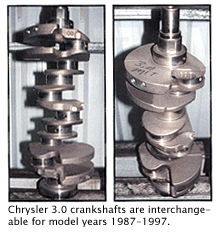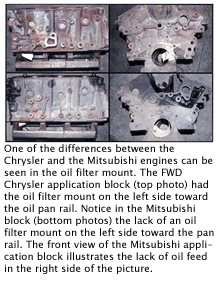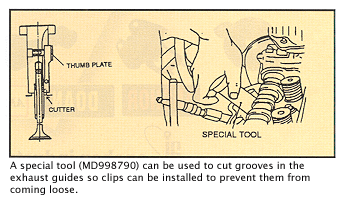Introduced in 1987, the Chrysler/Mitsubishi 3.0L V6 engine provided a much-needed boost in power for Dodge, Plymouth and Chrysler minivans over the existing 2.2L and 2.6L four cylinder engines. The original engine was rated at 140 horsepower at 5,000 rpm with 170 ft.-lbs. of torque at 2,800 rpm.
Built by Mitsubishi, the MMC 3.0L V6 has single overhead cams (SOHC) and a large bedpan-like cast aluminum air intake plenum atop the motor. The block is cast iron with aluminum heads and two valves per cylinder.
Over the years, this engine has been used in almost every Chrysler front-wheel-drive platform except the L-bodies (Omni/Horizon and Charger).
Evolving Design
Though the basic 3.0L V6 engine design remained essentially the same during its 10-year production run, there were some changes from one model year to the next. The 1987-’88 model year engines had a 52 mm throttle body, while later versions changed to a smaller 48 mm throttle body along with a redesigned intake plenum to reduce hood clearance. In 1989, the PCV system and valve covers were changed and the exhaust manifold outlets were increased from 2.25″ to 2.50″ for better breathing. In 1990, the flat tappet OHC cams and rockers were replaced with roller cams and rockers to reduce friction.
 In 1990, Chrysler replaced the SMEC (Single Module Electronics) computer with a more powerful SBEC (Single Board Electronics) computer – then replaced it in 1992 with an even better SMEC II computer when the change was made from ordinary multiport fuel injection to sequential fuel injection. The new setup provided each injector with its own driver circuit in the computer so each injector could be fired individually in sync with the opening of each intake valve. Earlier computers had two injectors sharing each driver circuit and gang fired the injectors once every revolution of the crankshaft.
In 1990, Chrysler replaced the SMEC (Single Module Electronics) computer with a more powerful SBEC (Single Board Electronics) computer – then replaced it in 1992 with an even better SMEC II computer when the change was made from ordinary multiport fuel injection to sequential fuel injection. The new setup provided each injector with its own driver circuit in the computer so each injector could be fired individually in sync with the opening of each intake valve. Earlier computers had two injectors sharing each driver circuit and gang fired the injectors once every revolution of the crankshaft.
In 1993, a flash reprogrammable computer was introduced on California minivans with the 3.0L V6. In 1994, the reprogrammable computer was added to the federal minivans.
In 1996, power output was increased to 150 hp by increasing compression slightly. The exhaust manifolds were also revised slightly to fit the redesigned minivan engine compartment.
The Engine’s Weaknesses
Over the years, the MMC 3.0L V6 has proven itself to be a real workhorse capable of racking up lots of miles. Some of these engines have gone 200,000 to 300,000 miles in aging minivans! But the years and miles also have revealed the engine’s major weaknesses. The main ones are oil leaks, oil consumption and valve guide/seal problems. The bottom end has proven to be rock solid, but the valve guides and seals (especially in the earlier motors) have been troublesome.
Timing Belt Diagram for Chrysler 3.0L Engine
In the back of each of the OHC heads is a black round rubber cam plug. If this plug pops out, the engine will quickly dump its oil supply and self-destruct. The cam plugs tend to loosen up during extremely cold weather so it is important to make sure they are leak-free and tight. If you replace these plugs, make sure you use the later “improved” versions, which are wider than the original narrow plugs.
The Positive Crankcase Ventilation (PCV) system on the 3.0L V6 sucks blowby vapors from the crankcase through the baffles that are built into the valve covers. There is also a drain hole in the covers so excess oil can drain back into the engine. If the drain hole becomes plugged, oil can be drawn into the PCV system causing a huge increase in the engine’s appetite for oil. Likewise, if the baffles are clogged with sludge, pressure can build up in the crankcase forcing oil to leak past other gaskets and seals in the engine. There’s no way to clean the baffles because they are located between the inner and outer liners in the valve covers. So if the valve covers are dirty and caked with varnish and sludge, they should be replaced with new ones.
To prevent sludge from returning, your customer should be advised to change the oil and filter regularly. Short-trip, stop-and-go driving, especially during cold weather, accelerates the buildup of moisture in the crankcase making 3,000-mile or three-month oil changes a must.
The 3.0L V6 uses pressed-in valve guides, which may work loose as the engine ages. The problem occurs mostly with the exhaust guides and allows oil to leak past the guide seal into the exhaust port. Chrysler says oil consumption is excessive if the engine uses more than one quart in 1,000 miles on vehicles with less than 50,000 miles on the odometer, or more than one quart in 750 miles on higher mileage engines. On engines built since 11/15/91 (build code BDL7.067), snap rings have been installed on the exhaust guides at the factory to prevent them from slipping, and on engines built since 10/2/92 (build code BDL7.416) the intake and exhaust valve stem seals were revised to improve oil control. The build code label can be found on the intake plenum.
 Examine the valve guides. If any can be moved with finger pressure or appear to be higher or lower than the others, the head will have to be removed so the guides can be replaced. Chrysler says the guides must be replaced if the distance from the top of the exhaust guide to the valve guide boss on the head is 0.335″ (8.5 mm) or less.
Examine the valve guides. If any can be moved with finger pressure or appear to be higher or lower than the others, the head will have to be removed so the guides can be replaced. Chrysler says the guides must be replaced if the distance from the top of the exhaust guide to the valve guide boss on the head is 0.335″ (8.5 mm) or less.
If the guides are not loose and have not slipped, a special tool (MD998790) can be used to cut grooves in the exhaust guides so clips can be installed to prevent them from coming loose. (See diagram below.) Use a magnet and a shop towel to remove the cuttings. Then install new positive valve seals on the guides, reassemble the valvetrain and valve cover and repeat the same procedure on the rear head.
Engine Replacement
If you’re rebuilding or replacing a high-mileage 3.0L V6 in a Chrysler FWD car or minivan, one thing you have to watch out for is to make sure the engine and transaxle are properly centered when the engine is reinstalled in the vehicle. This is necessary to prevent the FWD halfshafts from pulling out of the transaxle when the front suspension is extended to maximum travel.
To check centering, refer to a manual for the specified halfshaft dimensions (they vary from one application to another). Then use a tape measure to check the distance between the inner edges of the inboard and outboard CV joints on both shafts. If adjustment is needed, support the engine, loosen the side motor mounts and slide the engine left or right as needed to achieve the proper dimensions. Retighten the right side motor mount first, then the left mount to hold the engine in position.
 Something else to pay close attention to is the radiator and cooling system. If the original engine failed due to overheating, the radiator may be clogged and may have to be cleaned or replaced. Also, when refilling the cooling system, make sure all of the air is out of the system before the vehicle is driven. Check the operation of the cooling fan, too, to make sure it comes on when the engine is hot and when the A/C is turned on.
Something else to pay close attention to is the radiator and cooling system. If the original engine failed due to overheating, the radiator may be clogged and may have to be cleaned or replaced. Also, when refilling the cooling system, make sure all of the air is out of the system before the vehicle is driven. Check the operation of the cooling fan, too, to make sure it comes on when the engine is hot and when the A/C is turned on.
Maintenance
The 3.0L SOHC and DOHC V6 both use a rubber timing belt to drive the overhead cams. The recommended replacement interval is 60,000 miles with labor times ranging from 2.0 to 4.4 hours, depending on the vehicle model and power accessories. The easiest application to replace the timing belt on is the 3000 GT (SOHC version). All of the other applications will take 3.5 to 4.4 hours to change.
The SOHC version of the 3.0L V6 has enough valve-to-piston clearance so a belt failure should not cause any internal engine damage. But on the DOHC versions in the Dodge Stealth, Mitsubishi 3000GT and Diamante, it’s an interference application. A timing belt failure on one of these engines will usually bend one or more valves. The same goes for the 3.0L V6 engines in the Hyundai applications.
Replacing a timing belt on a 3.0L V6 is pretty much the same as replacing a timing belt on any other FWD engine. You have to remove everything that’s in the way, disconnect the passenger- side motor mount, and raise the engine slightly to remove the belt covers. Rotate the engine to align the timing marks (refer to a manual for their exact locations), then loosen the belt tensioner bolt, push the tensioner back and replace the belt.
Pay close attention to the condition of the belt tensioner. On high-mileage engines, the tensioner also should be replaced.
The water pump pulley runs off the timing belt, and considering how much effort is involved to get at these parts, it’s probably a good idea to replace the water pump, too. Also, check the tube that runs from the back of the pump to the back of the engine. Replace it if it is corroded or leaking. The service life of the OEM water pumps is about the same as the timing belt, so it makes sense to replace both at the same time. You may save yourself a comeback and you’ll certainly save your customer a lot of money on labor by doing both jobs at once.


